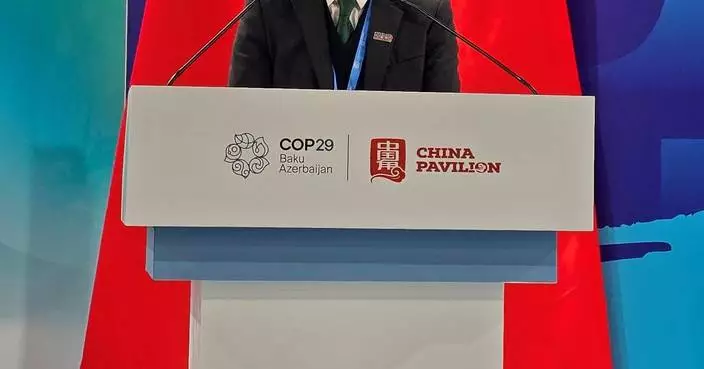Opening speech by SEE at COP29 China Pavilion's Side Event
Following is the opening speech by the Secretary for Environment and Ecology, Mr Tse Chin-wan, at the China Pavilion's Side Event: "Climate Action: From Climate Science to Opportunities to Develop New Energy" of the 29th Conference of the Parties to the United Nations Framework Convention on Climate Change (COP29) in Azerbaijan, today (November 13, Azerbaijan time):
Dr Chao Qingchen (Director-General of National Climate Centre, China Meteorological Administration), Director Wang Yi (Vice-chair of China's National Expert Panel on Climate Change), distinguished guests, ladies and gentlemen,
Good afternoon. With the support of the Ministry of Ecology and Environment, and the presence of leaders, professionals and experts in climate science and new energy, I am very privileged to be here at the China Pavilion of COP29 in Baku, and see so many friends here. Professor Saulo, Secretary General of the World Meteorological Organization (WMO) will join us later to share the work of WMO.
On fighting against climate change, I think we all know that China has pledged to achieve carbon peak before 2030 and carbon neutrality before 2060. For Hong Kong, to reduce carbon, we stopped the building of coal-fired power plants in 1997 and have been gradually shifting to natural gas and nuclear power. As a result Hong Kong reached carbon peak in 2014. Therefore we set an interim target to cut the emission by half before 2035 and achieve carbon neutrality before 2050.
Last year I told you that Hong Kong's per capita emission was about 4.5 tonnes in 2022. I am delighted to report that our emissions in 2023 was about 4.4 tonnes. Comparing to 2014, the reduction has been almost 30 per cent. As a reference, the 2023 United States’ carbon emission was 13.8 tonnes per capita. European Union in 2022 was 7.25 tonnes per capita. Therefore, Hong Kong is not doing very bad in this aspect.
To further reduce carbon, Hong Kong's Climate Action Plan 2050 has a four-pronged strategy. To achieve net-zero electricity generation, to promote green buildings and energy efficiency, to promote green transport and to find a better way to manage our waste.
You may wonder why waste is an issue relevant to carbon emissions. It is because in Hong Kong, we still use landfill for disposal of our waste. When the garbage is buried in landfills, they will decay and emit methane, which is a very strong greenhouse gas. Hence, Hong Kong needs to find a better way to manage our waste.
Under our strategy, there are 3 important targets. Today, coal still shares less than 20 per cent of the power generation in Hong Kong. Hence, the first is to stop using coal for power generation before 2035.The second target is to promote green transport, we will stop the registration of new fossil-fuel powered private cars before 2035, including hybrid. You may ask, how well Hong Kong is doing on that? In the first half of this year, out of 10 new private cars in Hong Kong, six or seven are electric. Therefore, I think the take-up rate is among the better in the world. The third target is to deal with methane from landfills. We are working to stop using landfills before 2035. For that purpose, the first waste-to-energy incinerator will come into operation next year and we will tender out in December to build the second waste-to-energy incinerator which will handle 6,000 tonnes of waste per day.
At the moment, about 25 per cent of the electricity in Hong Kong is nuclear power from the Mainland. To cut our carbon emissions by half before 2035, we need to further increase the share of net-zero carbon electricity supply, from the current 25 per cent to 60 to 70 per cent, by 2035. For that purpose, the current cross-border electricity transmission infrastructure is being enhanced and new infrastructure is under planning for completion also by 2035. 2035 is a magic and very important year for Hong Kong.
Hong Kong is also getting prepared for new energy solutions such as hydrogen. We have formulated the Strategy of Hydrogen Development in Hong Kong in June this year to capitalise on the environmental and economic opportunities from the global development of hydrogen energy. Our Commissioner for Climate Change, Mr Wong Chuen-fai, will introduce to you later about our vision and strategy on hydrogen development.
In the past 2 years, Hong Kong experienced two super typhoons, record breaking rainstorms, serious floodings, and this year we have the hottest ever Mid-Autumn festival in Hong Kong. It was 35.7 degree Celsius!
On adaptation, the Government has set up a working group led by the Civil Engineering and Development Department to look at our critical infrastructure, where they are, what they are as well as their design standards, and develop engineering standards and infrastructure plans to ensure that the infrastructure can stand for the extreme weather brought about by climate change. The vice president of the Hong Kong Institution of Engineers, Ir Frank Chan, will share with us the innovation in developing climate-resilient infrastructure in Hong Kong.
My dear friends, whether or not the world can achieve carbon neutrality before 2050, I can assure you that the climate will continue to change for decades. It is just the beginning. Therefore we also need to get prepared to deal with disastrous situations. In Hong Kong, our Chief Secretary leads a working group supported by all bureaux and departments to, in case necessary, rescue people and to help the city recover quickly from damages.
Our Hong Kong Observatory working with the Drainage Services Department, has developed a model using big data and artificial intelligence, trying to predict flooding risks a few hours before they actually happen, so that we can mobilise manpower to get prepared. That model is being tested. The Assistant Director (Development, Research and Administration) of the Hong Kong Observatory, Ms Sandy Song, will share with you more information on building of climate resilience through climate and weather services in Hong Kong.
While Hong Kong is working hard to fight against climate risks, some people may ask about how Hong Kong can contribute to other parts of the world in combating climate change. Hong Kong is a regional hub, a gateway from China to other parts of the world.
Mainland China, our motherland, has many innovative products and many new technologies that can help greening the future, reducing carbon emissions, which can help building infrastructures and cities in a green, low carbon, and safe manner. Hong Kong can be a gateway for introducing these green technologies and products to other parts of the world.
Looking further, to achieve the carbon neutrality goal, all sectors of society will need money to invest in decarbonisation technologies, research and development, capacity building, infrastructure, etc.
Being an international financial centre, Hong Kong is rising as an international green finance centre. The total green and sustainable debt issued in Hong Kong exceeded US$50 billion in 2023. Among this, the volume of green and sustainable bonds arranged in Hong Kong topped the Asian market in 2023, accounting for 37 per cent of the total.
We have, under the Government Sustainable Bond Programme, successfully issued since May 2019 Government green bonds totalling US$25 billion (HK$195 billion) equivalent, including green bonds denominated in Renminbi, USD, and Euro, retail green bonds, as well as a tokenised green bond.
To facilitate green finance flows, the Hong Kong Taxonomy for Sustainable Finance was published in May this year to provide a classification system that allows investors to identify and invest in activities that are making a positive impact on the environment. It aligns with the mainstream taxonomies of the Mainland and the European Union, and will be expanded to cover more sectors and activities.
We are also an international carbon market connecting opportunities across the Mainland, Asia, and the rest of the world. Core Climate has been launched to offer HKD and RMB settlement for the trading of international voluntary carbon credits. Looking ahead, it will continue to promote synergy with its Mainland counterparts to build a dynamic regional marketplace.
Accurate information is essential to green and sustainable financial services. The Government and financial regulators therefore aim for Hong Kong to be among the first jurisdictions, to align the local sustainability disclosure requirements with the ISSB Standards. This will help showcasing to international investors and markets Hong Kong’s commitment to reinforcing our leading position on the international sustainable finance map.
Ladies and gentlemen, climate change affects every corner of the earth. It is a challenge to combat climate change, but the green transition brings also new opportunities to all sectors of the community. I look forward to embarking on this green transition journey with all of you here today as we strive for carbon neutrality and a sustainable future for the world. Thank you.






